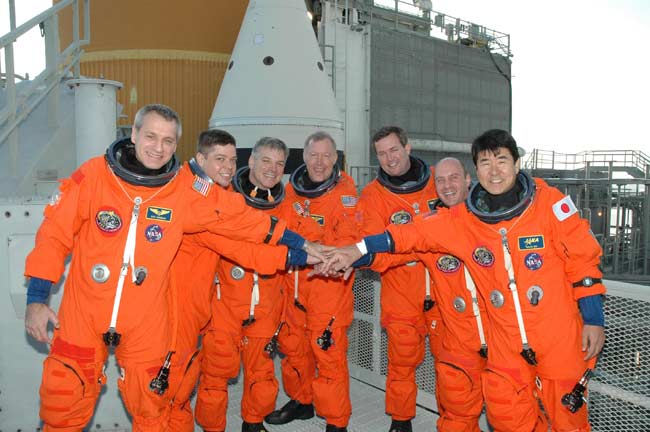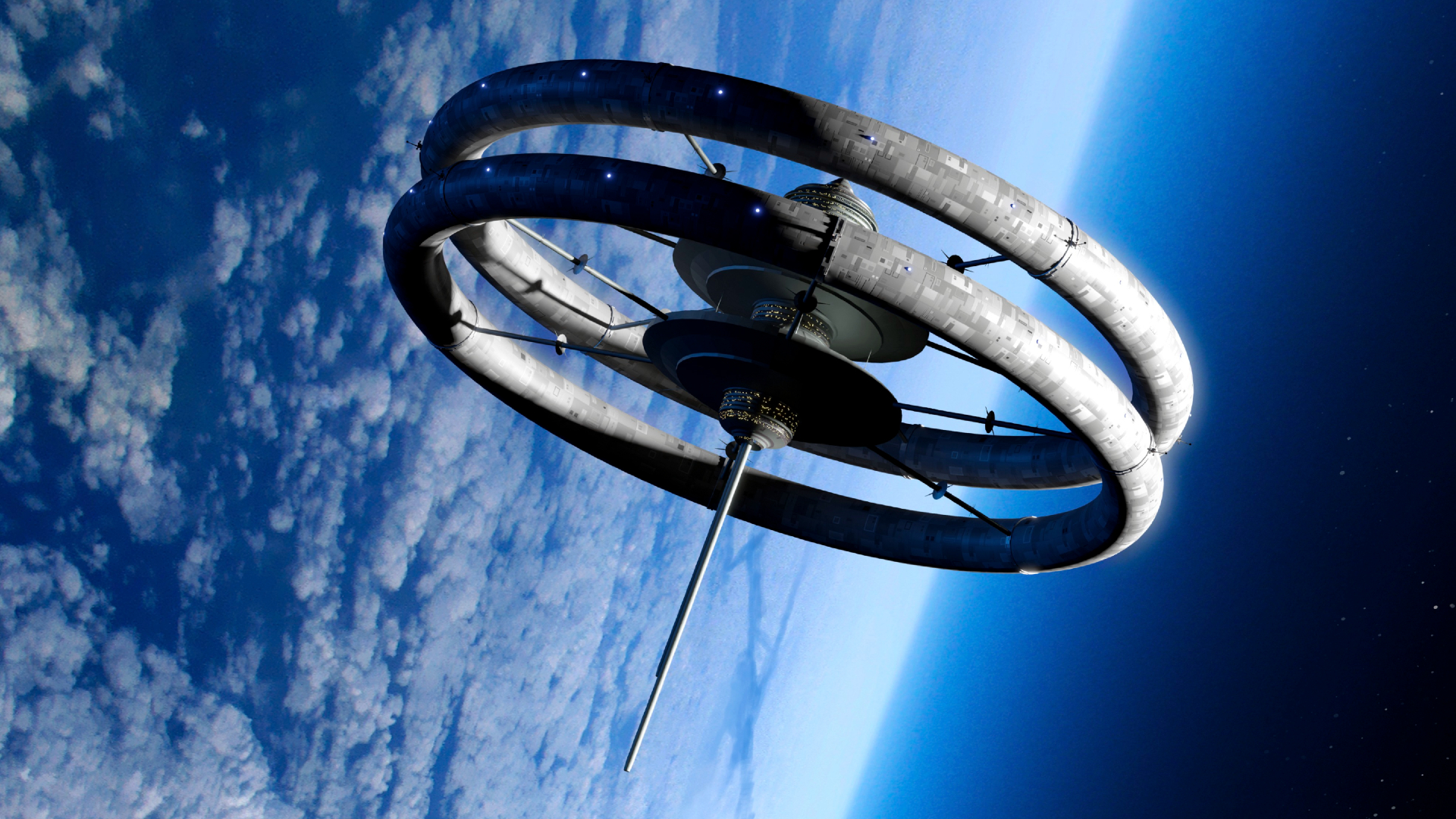Astronauts Eager for Marathon Station Construction Flight

WASHINGTON -The seven-astronaut crew of NASA?s shuttle Endeavour is gearing up for thelongest construction mission ever aimed at the International Space Station(ISS), where spaceflyers will add a Japanese-built room and a Canadian robot tothe growing orbiting laboratory.
Endeavour?sSTS-123 crew is on track for a March 11 launch toward the station from NASA?sKennedy Space Center in Cape Canaveral, Fla., to begin a marathonconstruction flight expected to last about 16 days.
?We are readyto fly this mission in another week,? said shuttle commander Dominic Gorie, a three-timespaceflyer, in a Monday briefing at NASA?s Johnson Space Center in Houston.?We?ve got everything on this mission that you can imagine.?
Gorie andhis crew are planning to launch - and land - in darkness, bookending a busyconstruction flight that includes five spacewalks to assemble the CanadianSpace Agency?s two-armed robot Dextre, install the first segment of Japan?smassive Kibo laboratory, test a shuttle heat shield repair method and deliverspare parts to the ISS. Two new international control centers, in France andJapan, respectively, will begin operations during the mission to activate theKibo component and prepare for the arrival Europe?s maidenISS cargo ship Jules Verne.
?We have avery international flavor on this flight,? said Mike Moses, NASA?s lead shuttleflight director for Endeavour?s mission. ?It?s going to be a busy, packedflight.?
Part ofthat international flavor comes in the form of Japanese astronaut Takao Doi, aveteran spaceflyer who will help deliver the storage room for his country?sKibo laboratory, dubbed the Japanese Logistics Pressurized module, to the ISSfor the Japan Aerospace Exploration Agency (JAXA). Japan?sKibo facility consists of a storage pod, a massive pressurized laboratoryand an external platform equipped with its own robotic arm. The country is theonly remaining major ISS contributor waiting to launch its first modules intospace.
?I feelhonored that I get to be one of the first people to get to go into the JLP,? saidDoi. ?Some people have been working on this program for more than 25 years,which is unbelievable.?
Breaking space news, the latest updates on rocket launches, skywatching events and more!
Endeavour?sSTS-123 mission will mark NASA?s second of up to six shuttle flights, five ofthem geared toward ISS construction, scheduled for this year.
The plannedspaceflight comes just weeks after the successfulFeb. 20 return of the shuttle Atlantis, which delivered the European SpaceAgency?s (ESA) Columbus lab and French astronaut Leopold Eyharts to thestation. Eyharts will return to Earth aboard Endeavour after the shuttleferries his replacement - U.S. astronaut Garrett Reisman - to the ISS.
Othertasks
In additionto delivering the Japanese module and Dextre, which is designed to replacespacewalking astronauts for some of simpler ISS exterior maintenance tasks,Endeavour?s crew will test a shuttle heat shield repair technique that uses acaulk gun-like tool to squirt a pink, heat-resistant goo into damaged tiles tosee how it behaves in space.
The repairmethod, one of several developed after heat shield damage led to the 2003 lossof seven astronauts aboard Columbia yet to be tested in space, has not yet beentested in the weightless vacuum of space. Engineers have found that bubbles inthe material tend to rise to the top during vacuum chamber runs on Earth andexpect some bubbling during the orbital test.
?I would bevery surprised if we had something that was totally unexpected,? NASA?s space shuttle program chief John Shannon told reporters.
Spacewalkerswill also return to the space station?s ailingstarboard solar wing joint, a 10-foot (3-meter) wide gear contaminated withmetallic grit that has hindered its ability to rotate outboard solar arrayslike a paddle wheel to track the sun. While NASA engineers believe the glitchcan be repaired late this year without affecting ongoing construction, theyhope to complete a full inspection of the gear that began in late October.
During themission?s fifth spacewalk, astronauts will also store Endeavour?s sensor-tippedinspection boom used to scan their shuttle?s heat shield for any signs ofdamage after launch and before landing. The astronauts will conduct a modified pre-landingheat survey while docked at the station before stowing the boom for the shuttleDiscovery, which is unable to carry its own boom in addition to the Kibo lab?s massive,tour bus-sized main segment when it launches in late May.
Orbitaltraffic
NASA hopesto launch Endeavour on either March 11 or March 12, before having to stand downfor the launch of a navigation satellite atop an unmanned Delta 2 rocket. Theshuttle must fly before March 23 to complete its mission in time for Russia?splanned April 8 launch of a Soyuz rocket carrying the station?s next crew andSouth Korea?s first astronauts.
But beforeEndeavour lifts off, European space officials hope to launch Jules Verne on ashakedown cruise that will eventually end with an early April docking at theISS. The mission was initially slated to launch late March 8 EST, but ESAofficials delayed the space shot by 24 hours earlier today to allow finalchecks on the spacecraft.
KirkShireman, NASA?s deputy ISS program manager, said ESA will attempt to launchJules Verne on March 9 and March 10, but would stand down on Endeavour?s launchday to clear communication satellite traffic for the shuttle?s liftoff.
?We?rethinking about launching an air traffic control here pretty soon just to keepit all straight,? Shireman said.
- VIDEO: ESA's New Science Laboratory
- IMAGES: STS-122 Launch Day
- SPACE.com Video Interplayer: Europe's Columbus Lab Sets Sail for ISS on STS-122

Tariq is the award-winning Editor-in-Chief of Space.com and joined the team in 2001. He covers human spaceflight, as well as skywatching and entertainment. He became Space.com's Editor-in-Chief in 2019. Before joining Space.com, Tariq was a staff reporter for The Los Angeles Times covering education and city beats in La Habra, Fullerton and Huntington Beach. He's a recipient of the 2022 Harry Kolcum Award for excellence in space reporting and the 2025 Space Pioneer Award from the National Space Society. He is an Eagle Scout and Space Camp alum with journalism degrees from the USC and NYU. You can find Tariq at Space.com and as the co-host to the This Week In Space podcast on the TWiT network. To see his latest project, you can follow Tariq on Twitter @tariqjmalik.
